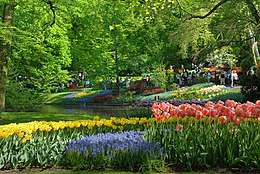Garden tourism
Garden tourism is a type of niche tourism involving visits or travel to botanical gardens and places which are significant in the history of gardening. Garden tourists often travel individually in countries with which they are familiar but often prefer to join organized garden tours in countries where they might experience difficulties with language, travel or finding accommodation in the vicinity of the garden. In the year 2000 the Alhambra and the Taj Mahal both received over two million visitors. This poses problems for the landscape manager.

The list of famous gardens which attract garden tourists from afar includes:
- Sissinghurst Castle Garden and Stourhead in England,
- Versailles, Giverny, Villandry, Rivau in France,
- Keukenhof in the Netherlands,
- Villa d'Este and Villa Lante in Italy,
- Alhambra in Spain,
- Longwood Gardens and Filoli in the US,
- Taj Mahal in India,
- Ryōan-ji in Japan.
Despite its popularity, garden tourism remains a niche commercial enterprise. Throughout the world, there are a limited number of boutique tour operators offering guided tours to the public.
Historical background

Initially, the garden tour in England and Wales involves private gardens and gardens that does not accept visitors regularly under the National Gardens Scheme, when "Gardens of England and Wales Open for Charity" (the 'Yellow Book') served as a guide book for those seeking to visit gardens in England and Wales.[1] The first issue of the Yellow Book was published as a supplement to a British magazine "Country Life" in 1931, after Elsie Wagg of an institution serving for district nursing came up with the basic idea of National Gardens Scheme, in which a charity and garden tour was combined when gardening was quite popular in the UK.[2]
The movement to open gardens for charity spread to private gardens when it was announced in 1927, and owners of such gardens agreed to collect 1 Shiring fee from each visitors that they donated to the charity. 609 such gardens raised £8,000 and in 1928 the institution renames to The Queen's Institute of District Nursing ("The Queen's Nursing Institute" of later day). With the publication of the first Yellow Book, there were 1,000 gardens to participate in the Scheme, and in 2015 they have donated £4.5 million since 1927. Those owners of private gardens sometimes donated to those charities they choose, amounting to £40,000.[2]
As the garden tour expanded since 1948 when the National Gardens Scheme involved the National Trust: while National Trust offered important gardens for garden tours which they have restored and conserved, and number of visitors increased. The Queen's Institute of District Nursing offered them funds which in turn encouraged the Trust to work on additional garden projects.[3] It was in 2013 when the Yellow Page was officially renamed as "Gardens To Visit".[2]
Garden tours and literature
Michel de Montaigne was one of the earliest garden tourists to record his impressions of gardens (c1580).[lower-alpha 1] John Evelyn also recorded his visits to gardens in France and Italy, as did Fynes Moryson.[lower-alpha 2] Maggie Campbell-Culver wrote a biography of John Evelyn as she sourced from woods and gardens Evelyn took steps in, and described trees from oak as an Evelyn's symbol to evergreens he favored the most.[7][8]
At the start of the 21st century, with a history of over 100 years of garden tours, Britain had the largest number of gardens open to the public for tourist visits: in 2013, 3,700 gardens are listed in Gardens of England and Wales Open for Charity, when the Yellow 3,500 gardens are listed in Gardens of England and Wales Open for Charity.[2]
See also
Notes
- The journal of Michel de Montaigne was discovered after his death, and published in 1774 as "Journal de voyage de Michel de Montaigne en Italie, par la Suisse et l'Allemagne en 1580 et 1581". Similar publication followed for example as with the editorship of Alessandro D'Ancona (1835-1914).[4] The 1774 edition is available in Pdf format; LIV-416 p with portrait of the author.[5]
- Fynes Moryson (or Morison) who visited in 1590s European and Mediterranean regions to publish first three volumes of his journal that he aspired to complete a set of 4 or 5 volumes.[6]
References
- "The National Gardens Scheme". The National Gardens Scheme (NGS). Archived from the original on 2016-03-10. Retrieved 2016-03-11.CS1 maint: ref=harv (link)
- The National Gardens Scheme (NGS) (2016-03-03). "Gardens To Visit 2016 (The Yellow Book)". Constable. ISBN 978-1-4721-2423-4. Archived from the original on 2016-03-15. Retrieved 2016-03-11.CS1 maint: ref=harv (link)
- "Feature". Follow the yellow guide road to great British gardens: Private gardens open for charity under the National Gardens Scheme and Scotland's Gardens Scheme. The Christian Science Monitor. 2002-04-24. Archived from the original on 2013-11-05. Retrieved 2016-03-15.CS1 maint: ref=harv (link) referred to HighBeam Research, for subscribers only.
- Michel Eyquem de Montaigne (1889). Alessandro D'Ancona (ed.). "Journal de voyage de Michel de Montaigne en Italie, par la Suisse et l'Allemagne en 1580 et 1581". Città di Castello : S. Lapi. Retrieved 2016-03-11.CS1 maint: ref=harv (link)
- Michel de Montaigne; Charles-Augustin Sainte-Beuve (1862-03-24). "Journal%20du%20voyage%20de%20Michel%20de%20Montaigne%20en%20Italie%2C%20par%20la%20Suisse%20et%20l%27%20Allemagne%20en%201580%20et%201581%2C%20avec%20des%20notes%20par%20M.%20de%20Querlon"%29 "Journal du voyage de Michel de Montaigne en Italie, par la Suisse et l' Allemagne en 1580 et 1581, avec des notes par M. de Querlon (pdf)" (in French). Anne-Gabriel Meusnier de Querlon (Annotation). Rome: Le Jay. Retrieved 2016-03-05.CS1 maint: ref=harv (link)
- Moryson, Fynes (1907). "An Itinerary: Containing His Ten Years Travel Through the Twelve Dominions of Germany, Bohemia, Switzerland, Netherland, Denmark, Poland, Italy, Turkey, France, England, Scotland and Ireland". Glasgow: James Maclehose and Sons. Retrieved 2016-03-15.CS1 maint: ref=harv (link)
- Maggie Campbell-Culver (2006). A Passion for Trees: The Legacy of John Evelyn. Eden Project Books. ISBN 978-1-9039-1947-7. Retrieved 2016-03-15.CS1 maint: ref=harv (link)
- "Diary: Gillian Darley". 28 (11). London Review of Books. 8 June 2006. pp. 38–39. Retrieved 2016-03-15.CS1 maint: ref=harv (link)
